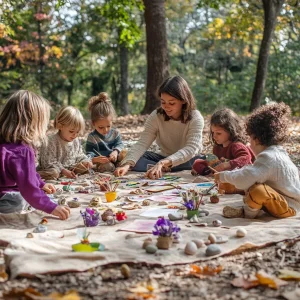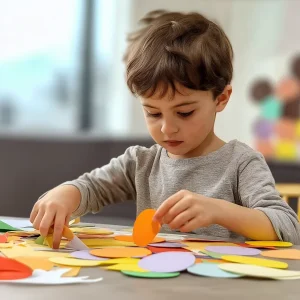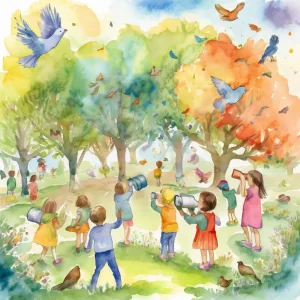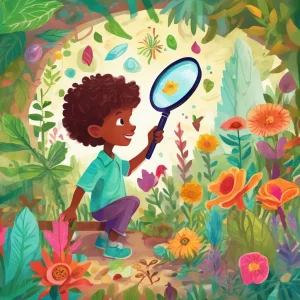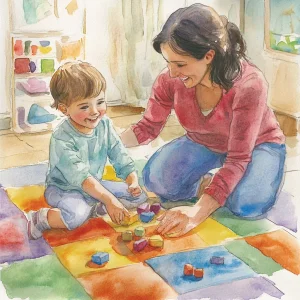Activity
Similar Activities
Nature Explorers: Scavenger Hunt & Art
Children’s Age: 2–6 years
Activity Duration: 10 minutes
Let's go on a Nature Scavenger Hunt and Outdoor Art adventure! We will explore nature, collect items, and create beautiful artwork. You will need a bag, paper, crayons, watercolors…
Activity Duration: 10 minutes
Rainbow Caterpillar Creation: A Colorful Adventure
Children’s Age: 6–10 years
Activity Duration: 10 – 20 minutes
In this fun activity called "Creating a Colorful Caterpillar," children can explore their creativity and improve their fine motor skills and understanding of sequencing. To begin, …
Activity Duration: 10 – 20 minutes
Melodies of Creation: The Musical Painting Adventure
Children’s Age: 2–3 years
Activity Duration: 15 minutes
Engage children aged 24 to 36 months in the Musical Painting activity, promoting creativity and motor development. Provide paper, paints, musical instruments, and lively music for …
Activity Duration: 15 minutes
Sensory Sound Box Exploration: A Musical Adventure
Children’s Age: 1–1.5 years
Activity Duration: 5 – 20 minutes
An engaging activity involving sensory exploration of sound using a variety of household items.
Activity Duration: 5 – 20 minutes
Enchanted Melodies: The Musical Tunnel Crawl
Children’s Age: 1–1.5 years
Activity Duration: 5 minutes
An engaging tunnel crawling activity with musical instruments for children aged 13-17 months.
Activity Duration: 5 minutes
Nature Shapes Adventure: Bird Watch & Scavenger Hunt
Children’s Age: 4–5 years
Activity Duration: 10 minutes
An outdoor activity for children aged 4-5 years combining bird watching and shape recognition.
Activity Duration: 10 minutes
Adventure of Rhyme and Move Outdoor Magic
Children’s Age: 3–4 years
Activity Duration: 10 – 25 minutes
"Rhyme and Move Outdoor Adventure" is a fun activity that combines nature-themed rhymes with movement in an outdoor setting. Children get to explore the outdoors, practice language…
Activity Duration: 10 – 25 minutes
Enchanted Nature Quest: The Sensory Nature Hunt
Children’s Age: 0 month – 6 years
Activity Duration: 10 minutes
Let's go on a Sensory Nature Hunt! We will use our senses to find items like pinecones, leaves, rocks, and flowers. You can bring a basket, a list of things to find, and maybe a ma…
Activity Duration: 10 minutes
Colorful Objects Sorting Game for Cognitive Development
Children’s Age: 1.5–4 years
Activity Duration: 10 – 15 minutes
This colorful sorting game is designed to boost your child's cognitive skills and nurture their curiosity. Gather safe, colorful objects like blocks or toys from your home. Place t…
Activity Duration: 10 – 15 minutes
Sensory Music-Making Session: Sound Story Drawing Adventure
Children’s Age: 2–2.5 years
Activity Duration: 5 – 20 minutes
A sensory music-making activity using household items to enhance sensory development and introduce children to the world of music.
Activity Duration: 5 – 20 minutes
Empathy Tales: The Storybook Creation Adventure
Children’s Age: 2–12 years
Activity Duration: 10 – 15 minutes
This activity helps children aged 2 to 6 develop empathy by creating a personalized storybook. You will need paper, crayons, stickers, scissors, glue, and story prompts like "A Day…
Activity Duration: 10 – 15 minutes
Imaginary Adventures: Mini Bowling Feelings Story Game
Children’s Age: 2–5 years
Activity Duration: 10 minutes
An engaging activity promoting sensory development, creativity, reading, and storytelling.
Activity Duration: 10 minutes




